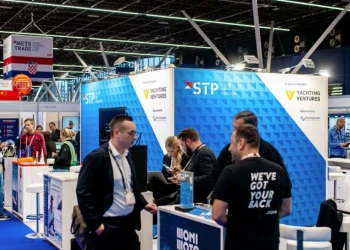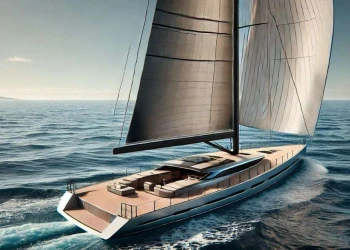
Metstrade: Construction, composites & eco-compatibility
Metstrade: Construction, composites & eco-compatibility
The marine industry is more and more committed towards eco-compatible solutions that respect the Earth and marine environment. An increasing amount of research is being pursued with the aim of creating ecologically compatible boats. Studies have been carried out to optimise technological processes and materials. Diesel-electric and pure electric propulsion systems have been developed with low noise and low emission characteristics, allowing navigation in protected areas and silence in mooring areas, in port and at anchor.
The rise of composites
From the 1970s onwards, boat construction has seen the increased use of reinforced plastic materials, to the detriment of metals and wood. The use of polymeric composites has become ever-increasing, thanks to a series of technical-economic advantages including high specific strength – the ability to present good mechanical characteristics with reduced weight. Fibre-Reinforced Plastic (FRP)composites are materials of great interest for the marine and naval industry, thanks to their lightness, mechanical strength and corrosion resistance. They consist of fibres, incorporated in a matrix of thermosetting (or thermoplastic) resins, usually polyester, vinylester or epoxy. However, they have some disadvantages related to environmental impact, as they still do not meet the ‘3R requirements’ (reduction, reuse and recycling). Furthermore, most of the polymers and reinforcements used in production come from non-renewable sources or require very significant energy consumption.
The problem of recycling fibreglass and composite materials in general has been considered and studied for some years. Despite considerable effort internationally to find economically sustainable solutions, fully satisfactory recycling solutions have yet to be established. It is important to emphasise that the frontier of ecological sustainability is no longer seen only from the point of view of the use of raw materials that should be degradable or easily disposed of at the end of their life. Priority should also be placed upon implementing efficient and low energy impact systems. Plus respecting the concept of ‘eco-compatibility’ embracing the use of materials that are not eco-friendly in themselves, but easily separable from one another.
What is a resin?
Technically, resins are high molecular weight organic polymers, obtained from a series of polycondensation reactions of various monomers and co-monomers. They are one of the two main components of the material that constitutes the fibre-reinforced composite structure. Resins are used to hold the fibres together and to transfer loads. Styrene is an aromatic hydrocarbon whose formula is C8H8. It is one of the main components of unsaturated polyester resins. It is present in volume between 35-45%.
The laminating technologies used by boatyards can be divided into two macro areas – open mould and closed mould. In the first category we find hand lay-up and cut and spray, while infusion, RTM (Resin Transfer Moulding) and VARTM (Vacuum-Assisted Resin Transfer Moulding), belong to the second category. During an open mould resin process a dynamic emission occurs, where the surface is constantly renewed with a consequent release of styrene. In the polymerisation phase, when the product is allowed to harden without applying further resin, we speak of static emission.
How harmful is this solvent? Is it carcinogenic or toxic? At international level there have been a series of legislative provisions (increasingly stringent) aimed at regulating and controlling the industrial activities involved in the process of placing harmful volatile compounds in the environment. The International Agency for Research on Cancer (IARC) has classified styrene in Group 2B which means it is a possible carcinogen for humans. Mutagenic properties are not established. However, the danger is ascertained. The question has been debated for years, but at the moment there are neither safe answers nor valid alternatives.
Infusion
In response to controlling emissions, manufacturers have turned increasingly to closed mould techniques. Infusion is a moulding process for semi-finished products in FRP, through which, the impregnation of the fibrous reinforcement occurs in a closed mould through the pressure difference that is created between the laminate and the batch containing the resin. The raw materials are: matrix, reinforcements, core materials and low-content or low-styrene polyester resins (phthalic, isophthalic, vinyl ester). As an alternative to polyester, epoxy resins are used. They are thermosetting polymers that usually come in the form of di-epoxide, that is a molecular chain of molecules at the end of which are the epoxy groups (CH2-O-CH) with which they react the binding agents during polymerisation.
Recycling
As mentioned before, recycling fibreglass and composite materials in general has not been very satisfactory to-date. Much remains to be done and validated in terms of treatment plants for the recovery / recycling of FRP in order to obtain technologically feasible and economically profitable industrial processes. Furthermore, the implementation of any FRP recovery / recycling process cannot be separated from the carrying out, upstream, of demolition, dismantling and disassembly of end-of-life products containing FRP. The cost-effectiveness of recycling also requires a rethink of the design process for boats. This needs to take into account their disassembly at the end of their life, and a reorganisation of the dismantling operations, which exploit automated processes to reduce the intervention of workers and improve safety.
Major steps
Currently, the use of composite materials is essential for the marine industry. It might be said the nautical industry has historically used this category of materials in a naïve way, but major steps toward technical and productive improvement have been achieved in the last decade, with widespread adoption of the vacuum infusion process for example. In fact, nowadays even the shipyards that do not produce hi-tech hulls, know about the most modern moulding techniques. There are many advantages deriving from these processes. To name just one, think of the drastic reduction of porosity and gaseous inclusions present in laminates obtained by hand-up up or by spray up with the consequent increase in the GC impregnation coefficient and relative specific resistances. The release of considerable quantities of harmful organic volatile elements in the environment has been reduced by 90%.
To conclude, we can certainly say that composite materials, to date, continue to present a series of degrees of freedom related to design and production technologies. It is precisely the optimisation of these variables, together with feasibility studies to be performed on significantly complex cases, which allows these materials to be applicable in an absolutely transversal manner and to overcome many traditional limitations of FRP.
Simonetta Pegorari





